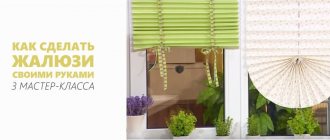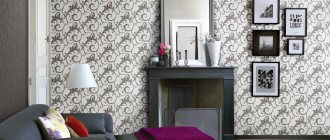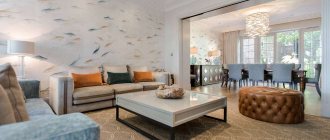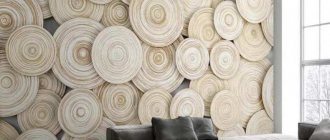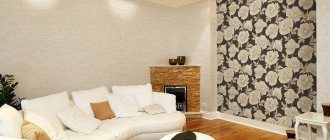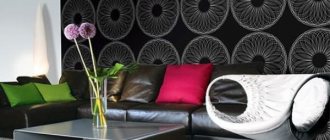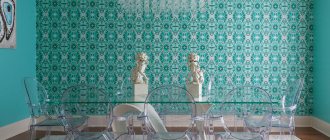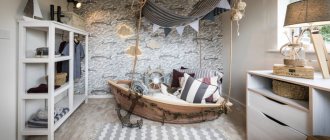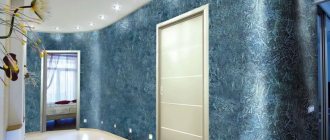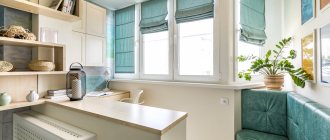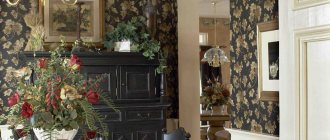For several years in a row, striped wallpaper has remained in fashion in the interior of most styles. Designer accents periodically shift to one or another classic color, but then linear patterns remain in demand again. Any interesting solution can leave a lasting impression, even simple colors in the form of frequent or rare stripes.
Striped wallpaper helps hide architectural imperfections and create beautiful effects in the space of the room
The relevance of striped wallpaper
As long as there is a classic interior, the target audience will choose plain, pastel and patterned wallpapers. However, residential real estate has many rooms that you probably want to modify.
And here is the time to use thematic cladding:
- Firstly, striped wallpaper injects energy into the interior;
- Secondly, stripes visually adjust the space;
- Third, strokes can serve as a focal point of attraction;
- Fourthly, color contrast and different sizes of stripes expand their scope of application.
It’s no wonder why such extravagant wallpapers are found even in classic interiors.
The main thing is to find out which stripes are suitable for the space depending on its purpose, style, shape, area and even lighting.
Materials
- Non-woven fabrics are made from natural and synthetic raw materials. For example, cellulose and polyester. Due to this, they are biodegradable (and therefore environmentally friendly), but at the same time durable. They are also distinguished by ease of installation. Because of this, they are used as a basis for vinyl wallpaper - there is no need to waste time waiting for the glue to be absorbed into the canvas.
- Textile - the base is the same non-woven fabric or paper, and the top layer can be jute, silk, velor or felt. This is one of the most expensive options.
- Fiberglass - used very rarely due to high cost. Made from natural materials, fire-resistant, waterproof.
- Metallized ones are the most expensive. Consist of paper and a thin layer of aluminum. Reliable, protect from electromagnetic radiation, retain heat, but they require special glue.
Horizontal stripes
Cramped space is a problem for millions of compatriots. While some are building the upper tier, others are using wallpaper with horizontal stripes to solve several problems at the same time:
- Visual expansion of space;
- Zoning of the premises;
- Creating a focal point of attraction.
The latter is obtained by using bright multi-colored wallpaper on one of the four walls (a wall with a bed or spot furniture is suitable for this technique).
It is better to decorate the remaining surfaces with wallpaper with two wide stripes of neutral or pastel colors.
How to stick borders correctly
First of all, you need to know that border tape differs in the method of gluing.
Some varieties are self-adhesive. In order to begin work, you only need to remove the protective tape from the adhesive layer. Others are simply impregnated with adhesive. In this case, you just need to slightly moisten their base, wait a couple of minutes and stick on. But most still require the same actions as regular wallpaper
In this case, you need to pay attention to the glue itself, which should be marked on the packaging “for wallpaper borders.” Or ask the seller to select the required option.
As for the gluing process itself. Many people mistakenly believe that the border is glued directly on top of the wallpaper. This option is acceptable only if a paper border is used on paper wallpaper. Due to the minimal thickness of this material, no bulges will form on the wall surface in the future, and the frieze itself will stick easily and reliably. If other materials are used, the border is glued only to the wall. Therefore, it is necessary to begin work by preparing the surface itself:
If it has defects in the form of deep scratches or dents, they must be smoothed out with a layer of putty. After drying, it must be sanded with fine sandpaper or a special mesh to remove irregularities. After this, the entire surface to be pasted is primed. After the soil has dried, it is very important to mark. This will be the key to the correct placement of the border on the wall.
To do this, use a building level and a special painting line. With one movement you can accurately apply markings over a large length at once.
Now you need to measure how much tape you will need. Don't cut end to end. Leave a centimeter of extra space at each joint. The excess can be easily removed with a stationery knife, but gaps will be clearly noticeable if there is a shortage of material. To simplify the work, it is recommended to cut long borders into pieces 1-1.5 meters long. In this case, too, do not forget about the reserve. Cut the border in places where the design will most easily fit together. This will make your work much easier.
When you have properly prepared the walls, marked them evenly and cut the frieze, you need to start mixing the adhesive and the main work.
- Let the glue sit a little and start applying. The layer should not be too thick. Do not apply the composition to the entire length of the wall at once. For the first time, it is enough to coat an area equal to the length of the strip. In some cases, glue is applied to the border edging. You need to let it sit for a few minutes so that it gets saturated and only then glue it. This feature will be specified in the instructions for the border tape itself.
- Follow the markings carefully. Since the border tape is often applied first, it will give direction to the main wallpaper. In case of misalignment, it is better to transfer the work.
- Immediately wipe off excess glue from the surface of the frieze with a soft cloth.
- The joints of two strips must be rolled with a roller.
- When you reach the corners, make sure that the edge of the break overlaps the adjacent wall by at least one centimeter. This will ensure a joint without gaps.
- If you are decorating a window or doorway with a border, it is better to join the edges at an angle of 45 degrees. You should not do this immediately before gluing. Place the tape around the perimeter of the opening with a margin. So that its edges overlap each other and form the letter P. Without waiting for it to dry completely, take a ruler and a sharp knife. Attach the ruler at the required angle to the wall, press down well and draw with a knife. Do not press too hard to avoid pulling on the edge of the blade. Once you've made sure you've cut all the way through both layers, carefully remove any excess pieces and roll the joint. You will get a perfectly even bevel.
As you can see, the process of pasting regular wallpaper is even more complex and time-consuming than decorative borders. By following these tips and doing everything consistently and carefully, you will certainly cope with this task perfectly.
Vertical stripes
Sometimes inside a property you have to work with the background, updating it with vertical stripes. Thematic cladding allows you to visually increase the height, despite the following disadvantages of the room:
- Small area;
- Low ceiling (due to traditional design or suspended ceiling);
- The presence of a ceiling cornice;
- The space is busy with a chandelier, shelves and paintings.
If the problem room is a corridor or hallway, then vertical stripes create the effect of an air portal.
The main thing is that they are light and matte, and the ceiling is white. In other rooms, the colors and sizes of the stripes are selected depending on the area and lighting. The lower these indicators, the wider and lighter the strokes should be.
Variety of shapes and materials
The colors, materials, and textures are so varied that choosing the right option is easy. A well-chosen frieze can raise the design of a room to new heights. The main thing is not to get carried away with the variety of materials, textures and colors, so as not to create a feeling of chaos in the room.
Shape and textures
The most convenient option for wallpaper border from an aesthetic point of view is a smooth strip. It fits most styles, but is unlikely to decorate a boring interior. Manufacturers offer various types of frieze:
Smooth matte or glossy. Easy to use, fits easily into any design. Textured
Embossing attracts attention and breaks up the smooth surface of the walls. Lace. This is a complex type of design, suitable only for “palace” styles
The design on the border should be combined with design elements on other surfaces or furniture. Coated with a golden or silver tint. This frieze is even more difficult to fit into the design. If the rest of the design does not have elements of this color, then lonely splashes of gold and silver look out of place.
It is dangerous to combine dissimilar textures in one interior. Professionals sometimes achieve striking effects with this trick, but it's much safer to combine textured wallpaper panels with smooth surfaces, or vice versa.
What is edging made from?
The choice of material depends on the style and color scheme of the interior:
- Paper. The thinnest and most fragile version of the wallpaper border loses color saturation when exposed to sunlight. Paper strips adhere well when gluing, but they are difficult to work with. The material gets wet quickly and is easily damaged. The main advantage is low cost.
- Vinyl. This material is much stronger than paper, is not afraid of the sun, and will last a long time. The vinyl frieze is washable. It withstands high humidity in the kitchen or bathroom.
- Acrylic. This is a polymer material with characteristics similar to vinyl, but with greater resistance to fading and abrasion. The cost of acrylic borders is usually slightly lower than vinyl ones.
- Textile. Double-layer strip of paper and fabric. Most often, the top layer is made of velor. The border looks impressive, but, unfortunately, is impractical. The fabric cannot be washed, much less rubbed, as dust accumulates on it. If the edging is located low, abrasions from contact with furniture, damage from the claws of pets or careless movements of the owners are possible.
- Fiberglass. Reliable, practical, beautiful, but expensive.
Gluing thin paper borders to walls with wallpaper made from expensive materials is not the best idea. This will simplify the design. Expensive borders on cheap paper wallpaper are also inappropriate. Contrary to expectations, they will not add luxury to the room, but will only highlight the design flaws.
Diagonal stripes
The thematic cladding seems exotic. But when the attic renovation is at stake, then you have to:
- Finish triangular walls with appropriate touches;
- Choose diagonal stripes of neutral colors to ensure the entire background is balanced.
Neutral colors include the use of white, gray, beige, cream and sand colors. The dark color in the zebra pattern should be muted so as not to overload the space.
Kitchen
White color and pastel palette are ideal for the kitchen. Graphics in these colors will fill the space with cleanliness, warmth, and comfort.
To break up the monotony, you can make one wall an accent wall. It will be something like a panel. The choice of design should be approached thoroughly; it should fit into the overall concept of the style.
We recommend reading:
- Original painting of walls in an apartment - cheap and beautiful: photo examples of painting walls
- Turquoise walls - design ideas, stylish combinations and design features (130 photos)
- Photo frames on the wall - placement ideas and options for decorating walls using photo frames (115 photos and videos)
Black and white stripes
Thematic panels and tiles inside the bathroom are no longer uncommon. This approach adjusts the space and stylizes the interior. By the way, lamps and other bright accessories always look advantageous on a black and white background.
Therefore, black and white wallpaper is suitable for the following interiors:
- Art Deco;
- Fusion;
- Minimalism.
Inside living rooms, zebra stripes should be used sparingly - on one or two walls. Such planes welcome large black and white photos with a white mat and the proximity to vertical colored blinds.
Tips for choosing a color palette
If the design of the kitchen room contains small details, drawings and patterns, then it visually appears larger than it actually is. However, if the interior contains many large images, then the opposite effect will occur, that is, the kitchen will appear smaller.
To achieve a feeling of continuous space, you can use wallpaper with intersecting stripes for the walls of the kitchen area.
Textured finishing material looks original in the kitchen, and it helps to create an additional dimension in the room. The play of shadows and penumbra in combination with different color schemes will give kitchen walls a huge number of interesting effects.
Patterned stripes
Stripes are not always monochromatic strokes. The latter can be supplemented or replaced with patterns, flowers, and ornaments.
This makes it clear why striped wallpaper is suitable for the following classic interiors:
- Empire;
- Provence;
- Ethno (Scandinavian style);
- Country.
The main thing is that patterned stripes correct the space no worse than ordinary strokes. Therefore, themed wallpaper is used on all four walls.
Each style has its own lines
The following ornaments are designed for a specific style direction:
- for classics, choose non-contrasting stripes of medium width;
- Pop art has a riot of colors, so any width, shades, contrasts are allowed;
- wide stripes without color conflicts are preferable for modernism; they successfully enliven the atmosphere of minimalism;
- in high-tech - black and white wide version, there is no room for compromise;
- white and blue, of course, emphasize the tenderness of the Mediterranean style, but only in combination with plain wallpaper;
- in Provence this pattern is acceptable, but it should be gentle, warm, and romantic.
Shiny stripes
Gloss promotes prestige. It is not for nothing that Rococo and Baroque interiors stand out with gilding. If you don’t have the energy and time to create an imperial background, then instead of Venetian paint you can use shiny stripes.
Such fragments are found on the following types of wallpaper:
- Glass wallpaper;
- Fabric wallpaper;
- Non-woven wallpaper.
The last ones are the most accessible. They apply glitter only to specific stripes so that the finished product looks harmonious. This property is also facilitated by the alternation of only two stripes. Moreover, the strokes are usually directed upwards.
Let's sum it up
There are many options for using wallpaper in the kitchen, and our portal offers a large number of photo and video materials on creating a kitchen interior and it is not at all necessary to resort to the help of a professional designer.
The instructions for using these materials are simple and the design of your kitchen that you eventually get will delight you for a long time.
Gallery
Did you like the article? Subscribe to our Yandex.Zen channel
Great article 0
Solid stripes
The best way to balance the colors of striped wallpaper is to make it a solid color. Horizontal plain stripes in pastel colors suit the bedroom.
The following touches are also suitable for the living room, but their pastel color scheme should be light:
- Sand;
- Peach;
- Beige.
Plain stripes deprive the interior of constructivism, so they are unlikely to suit the dressing room and kitchen. On the other hand, workrooms can be designed in a classic manner or have a small area.
Finally, there is often not enough light inside the dressing room. Light monochromatic stripes not only expand the space, they contribute to lighting.
What to do first: glue wallpaper or install doors
Many people believe that when starting a renovation, they should first install the doors, and only then take on the wallpaper. If you don’t do this, unpleasant things may happen: the opening for the door, in which the doors will later be installed, may be uneven, which will greatly affect when wallpapering. This mistake is often made by inexperienced people who are doing repairs for the first time.
If a person has previously hung wallpaper, he will have to re-glue it. The result is double work, which costs twice as much effort and money. But if the doorway is truly perfectly level for future doors, then this problem is not so critical.
(no votes yet)
Narrow stripes
With narrow stripes, the wallpaper becomes bright, even if the colors of the strokes are neutral or pastel. The fact is that the small width of the stripes increases their number. From a distance, such wallpaper may seem monotonous. But inside a tight space it is very difficult to move away from the background.
Therefore, wallpaper with narrow stripes is recommended for use in certain cases:
- Creating a focal point of attraction - should be pasted on one wall;
- Adjacent to vertical blinds or muslin curtains - the stripes should be directed downwards;
- Completion of an ultra-modern interior - fusion, avant-garde, hi-tech.
If narrow stripes are made in one light tone, then they will suit a classic interior. But to match the appropriate background, you will have to purchase a lot of light-colored products - furniture, curtains, bed linen, etc.
Not every item has to look like marble. However, the dominance of light colors over dark ones contributes to the feeling of spaciousness.
Features of striped interiors
There is nothing simpler than a striped wallpaper pattern, but it is in this simplicity that lies a huge variety of unsurpassed solutions. To the ignorant, it is surprising how easy it is to create a memorable and stylish setting using combinations, using a simple horizontal or vertical, parallel or gracefully meandering line.
The variety of wallpaper patterns allows you to choose the ideal combination of width and direction of stripes for any interior
Designers are increasingly offering wallpaper with diagonal and combined stripes in the interior of the hallway and living room, bedroom and kitchen. It doesn’t matter whether wide or narrow fragments of the same color alternate, contrasting or blurry. With such a “ruling” it is easy to transform any space and adjust its visual perception.
The most “boring” or classic interior can be easily diversified, adding dynamism and bold accents. To do this, just decide to experiment with striped wallpaper in a residential interior. This traditional coloring is quite suitable for combination with plain surfaces and any recognizable pattern. You can try combining a cage, polka dots, floral patterns, abstraction or elegant geometry on one wall, combining them with wide horizontal lines, as in the photo.
Alternating vertical stripes with geometric patterns in a single color scheme
The striped floral pattern adds romantic motifs to the interior.
What is “striation” used for? Not only for variety, but purely for practical purposes - a combination of stripes easily transforms any space, even creating spectacular illusions of “moving” walls. Visually, you can make a small room with low ceilings a little higher and wider, as if “adding” volume and footage.
Accent wall in a narrow room
A few bright stripes will break up the monotony of white walls.
Interestingly, it is not necessary to change the entire interior if it turns out unattractive after renovation. It is enough to add dynamism with striped wallpaper in the living room using stripes on one accent wall:
- vertically and horizontally;
- diagonally and in different directions.
Horizontal lines make the room wider, so it is better to use this technique on the end wall. By combining horizontal and vertical stripes, it is possible to create unexpected effects, including “running” walls.
When wallpapering with horizontal stripes, the room will visually become wider by at least a couple of squares
Vertical stripes will “raise” a low ceiling
Extensive vertical stripes, like columns, “raise” the top, especially when combined with multi-level structures and glossy fabric. But even with an ordinary white ceiling there will be a noticeable effect, as in the photo.
However, you should not be “full” of contrasts “everywhere and at once” - an incorrectly chosen combination can tire, especially in a nursery.
A skillful combination of a linear pattern with something discreet, floral patterns and faint spots will activate the mind and encourage creativity. This is especially valuable in a teenager's room or a student's office.
Wallpaper in the nursery can be gray-blue, gray-white or gray-pink striped
You can use striped wallpaper in almost any style. They are easy to combine with other linear patterns:
- vertically and horizontally;
- variations of shades in one color and contrasting ones;
- modest and colorful;
- only stripes or with inserts (winding lines, flowers, ornaments);
- wide and narrow fragments;
- weakly expressed and catchy (such as “zebra”);
- wide rolls and narrow.
Close-up pattern with stripes in different directions on the wallpaper in front of the console table
If you get creative with the combinations of lines, it's easy to create a creative design in any living space.
However, it is important to take into account the wishes of all family members - perhaps someone will be categorically against graphic stripes in their room.
For those who prefer a calm interior, it is better to choose wallpaper with monochrome stripes without sharp contrasting transitions.
See alsoWhich wallpaper to choose for the hallway?
